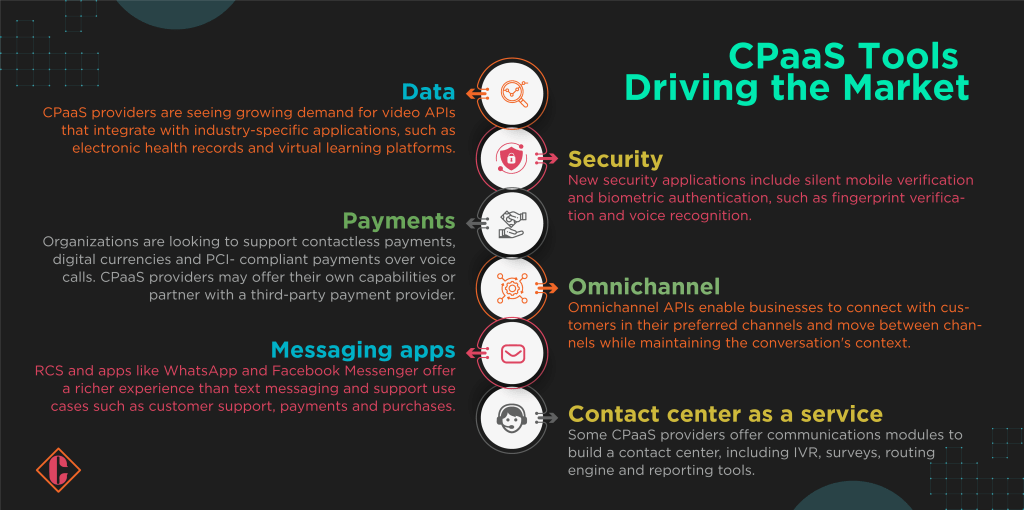Innovation stands as the cornerstone of success in the evolving technology industry. Embracing technological advancements is not just a trend but a necessity, especially regarding communication. Enter CPaaS, or Communications Platform as a Service—a dynamic cloud-based delivery model empowering organizations to integrate real-time communication capabilities into their business applications seamlessly. By deploying Application Program Interfaces (APIs), CPaaS enables the augmentation of business tools with functionalities like voice, video, and messaging.
According to the Future Market Insights report, the CPaaS market is forecasted to achieve approximately US$ 59,362.1 million by 2032, with an anticipated compound annual growth rate (CAGR) of 25.0% from 2022 to 2032.

The extensive communication capabilities facilitated by CPaaS APIs span SMS (Short Message Service), MMS (Multimedia Messaging Service), telephony, and video, empowering businesses to embed these services directly into their applications. From sales software enhancements like notifications and click-to-call features to bolstering security through multifactor authentication (MFA), CPaaS offers a versatile toolkit for enriching business interactions.
Designed for organizations seeking to embed communications within their applications. CPaaS also caters to cloud service providers and developers aiming to enrich their services with communication functionalities. These platforms boast standards-based APIs, comprehensive software development kits (SDKs), and libraries compatible with Java or .NET for constructing applications across diverse platforms. Additionally, CPaaS providers often offer packaged bundles comprising fully functional communication features that can seamlessly integrate into applications.
Leveraging cloud technologies, companies aim to render communications more adaptable, engaging, and cost-effective, stimulating revenue growth while concurrently mitigating expenses. McAfee’s survey underscores this transition, revealing that 87% of companies leveraging cloud services witness business expansion. Consequently, businesses risk falling behind in the fiercely competitive modern markets if they neglect the integration of cloud solutions—where CPaaS emerges as a linchpin for streamlining customer communications efficiency.
Central to CPaaS offerings are vital features that transcend traditional communication norms. These encompass advanced voice functionalities enabling automated, personalized, and impactful interactions, high-quality video communication facilitating seamless collaboration, and enhanced messaging capabilities optimizing customer-agent communications across multiple channels.
 Understanding CPaaS: How It Revolutionizes Business Communication
Understanding CPaaS: How It Revolutionizes Business Communication
- Integration of Real-time Communications: CPaaS enables developers to seamlessly incorporate real-time communication features into existing business applications, bypassing the need for standalone communication platforms like Microsoft Teams or Skype.
- Diverse Communication Features: These CPaaS features encompass live chat, SMS, voice, and video calling, enriching business applications with comprehensive communication functionalities alongside their primary functions.
- Facilitation by Third-party Services: Third-party CPaaS services equip in-house developers with essential tools such as standards-based APIs, sample codes, and prebuilt applications. Additionally, some services provide software development kits (SDKs) housing libraries for streamlined integration.
- Cloud-based Implementation: As a cloud computing service, CPaaS allows the integration of communication features into applications without necessitating companies to invest in building their individual backend infrastructures.
- Flexible Billing Models: CPaaS services commonly operate on a monthly fixed-rate billing structure for message or minute blocks. Alternatively, providers may offer pay-per-call, per-video, or per-message billing models. This approach presents organizations with a cost-effective alternative to developing custom communication applications.
- Focused Deployments and Application Areas: Early CPaaS deployments have targeted applications in Telehealth, field services, education, customer service, call centers, and social media. Noteworthy CPaaS-enabled application features encompass video-enabled help desks, in-app messaging, and authentication services.
CPaaS Use Cases
Businesses leverage CPaaS to adopt an omnichannel communication approach, ensuring seamless internal interactions and enhancing customer experiences.
1. Appointment Confirmations and Fulfillment Updates
CPaaS conveys crucial messages like appointment confirmations, order acknowledgments, and delivery status updates. Implementing these messages yields numerous advantages, reducing missed appointments, enhancing customer communication and satisfaction, and automating reminders and updates.
These messages find utility in healthcare, food delivery, e-commerce, and industries reliant on subscription models and recurring payments.
2. Fraud and Abuse Mitigation
Employing CPaaS fortifies customer security by utilizing text messages to deliver one-time passwords (OTPs) for user verification, two-factor authentication codes for secure logins, and safeguarding mobile payment details. This use case extends to any industry handling customer accounts or online transactions, such as online shopping, software tools, and personal banking.
3. Scalable Voice and Messaging
CPaaS empowers businesses to integrate voice calling and messaging seamlessly into customer-facing applications. This facilitates easy customer contact during critical stages of their purchasing journey, such as product/service acquisition, planning physical visits, or reviewing account/purchase history.
Industries like travel and financial services benefit significantly from deploying scalable voice calls and messaging, offering immediate assistance during pivotal customer touchpoints.
4. Automated Customer Interactions
Leveraging CPaaS for chatbots and automated customer engagement streamlines customer inquiries through self-service platforms. Chatbots equipped with conversational AI efficiently address recurring customer queries by analyzing customer data, past interactions, and inquiries.
Key Considerations for Choosing a CPaaS Provider
- API Quality and Selection: Prioritize vendors offering well-tested, reliable, and robust APIs. Assess the breadth and depth of APIs available, ensuring compatibility with preferred programming languages.
- Developer Learning Curve: Some vendors provide modules or wrappers tailored for developers with varying coding proficiencies, facilitating smoother integration for those with limited programming skills.
- Time in Market: Consider the vendor’s tenure in the market. Smaller or newer CPaaS providers might carry potential acquisition or closure risks, potentially disrupting service continuity.
- User and Developer Community: A vibrant user community augments the value of a platform, offering developers resources and support to maximize the service’s potential.
- Network Infrastructure Strength: Opt for vendors capable of delivering consistent and dependable service underpinned by robust network infrastructure.
- Data Security: Ensure vendors uphold stringent data security measures. Providers must guarantee the protection of sensitive data by implementing rigorous monitoring across their platforms and applications.
Top CPaaS Providers for 2024
Microsoft Azure Communication Services
Microsoft Azure Communication Services (ACS) is a powerful CPaaS tool within the expansive Azure ecosystem. Recognized for its leadership in the UCaaS market, Microsoft has secured prominent positions in Gartner’s Magic Quadrant.
ACS offers various tools and APIs, enabling seamless real-time video and voice communications integration into existing systems. Its development platform, hosted within the managed Azure environment, provides access to Visual Studio and GitHub tools. Additionally, users benefit from open-source SDKs that effortlessly align with established tools like Microsoft Teams. Continuously evolving, Microsoft is expanding its service offerings with innovative investments, exemplified by recent ventures like integrating disruptive tools such as ChatGPT into their repertoire.



 Understanding CPaaS: How It Revolutionizes Business Communication
Understanding CPaaS: How It Revolutionizes Business Communication